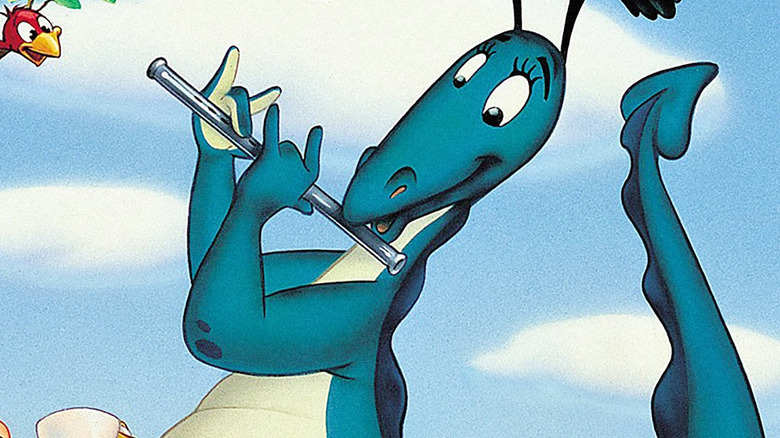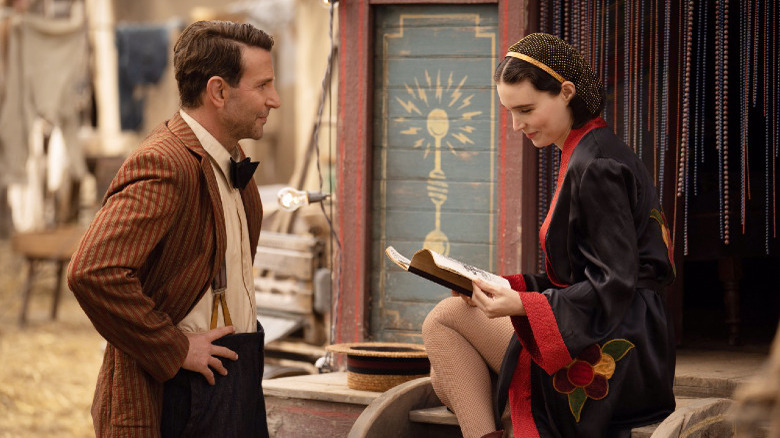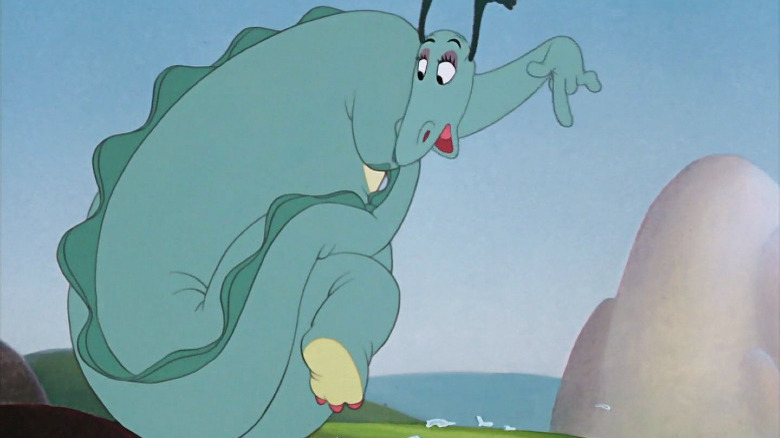The Bizarre Reason Disney's The Reluctant Dragon Was Censored
The House of Mouse has long prided itself on providing wholesome entertainment for the masses with its feature films. Yet, as you might expect, there have been plenty of exceptions to that rule dating back to the company's early days — from Disney movies that featured racially and/or culturally insensitive depictions of certain people and places (like "Song of the South" and "Peter Pan") to films that included grisly acts of violence (like 2013's "The Lone Ranger," where one of the villains is a cannibalistic outlaw). Curiously, however, one of the rare cases of a Disney movie being censored came about for a very bizarre reason that had nothing to do with offensive or mature content.
That would be 1941's "The Reluctant Dragon," a live-action/animated hybrid film in which humorist and comedian Robert Benchley (portraying a fictional version of himself) meets Walt Disney and various now-legendary members of his animation department (all similarly playing "themselves") while trying to convince Disney to buy the rights to Kenneth Grahame's 1898 children's story "The Reluctant Dragon." But to explain why the movie was censored, we first need to talk about the infamous Motion Picture Production Code, AKA the Hays Code.
The Hays Code Explained
Published in 1930 and put into effect by 1934, the Hays Code was a set of industry guidelines drawn up by the Motion Picture Producers and Distributors of America (MPPDA) in the 1920s under the leadership of William Harrison Hays Sr. A politician and Presbyterian elder, Hays had only just resigned as U.S. President Warren G. Harding's Postmaster General due to his role in the Teapot Dome scandal (an event which inspired Upton Sinclair's "Oil!," the book Paul Thomas Anderson adapted into "There Will Be Blood") when he became the head of the MPPDA in 1922.
Hays' appointment came on the heels of a series of much-publicized Hollywood scandals and growing complaints about movies with "indecent" subject matter, which led to U.S. legislators from no less than 37 states proposing censorship bills in 1921. This, in turn, gave rise to the creation of the so-called Hays Code, with the idea being the film industry would regulate itself using a set of rules divided into two categories: 1) "General Principles" that called for movies to depict the "correct standards of life" and 2) "Particular Applications" that forbid the depiction of things like nudity, specific curse words, interracial relationships, and any forms of queer sexuality.
The Hays Code was strictly enforced from 1934-54, and its influence can be felt in the movies from that period. For example, in 1947's "Nightmare Alley," lovebirds Stan and Molly are forced to get married when their fellow carnival workers uncover their romance, lest anyone think the film was suggesting that sexual relationships out of wedlock are okay. True, the pair tied the knot after leaving the carnival world in the original 1946 novel, but it's telling that the Hays Code-era adaptation made such a great hullabaloo about this when Guillermo del Toro's 2021 movie (with Bradley Cooper and Rooney Mara playing Stan and Molly) didn't include the marriage angle at all.
No Belly Buttons Allowed
Thanks, in part, to the success of such non-Code approved films as 1959's "Some Like It Hot," the Hays Code weakened over time before being succeeded by the MPAA film rating system in 1968. Of course, it was alive and well when "The Reluctant Dragon" was in production — as David Swift (a Disney animator and the director of 1961's "The Parent Trap") noted during an interview he gave with Ward Kimball, a member of Disney's original core animation team known as the Nine Old Men. Kimball was also among the animators who played themselves in the live-action portions of "The Reluctant Dragon," leading up to the movie's final animated segment (which adapts Grahame's titular story).
As Swift recalled to Kimball:
"Do you remember when they sent 'The Reluctant Dragon' back, the whole thing to be repainted, because the Hays office wouldn't let them put a belly button on the dragon, remember that? 'The Reluctant Dragon' was almost ready for release, and the Hays office looked at it and said, 'You can't show the navel,' they had to send the entire picture back. On a dragon."
Sure enough, the dragon's belly button is nowhere to be seen in "The Reluctant Dragon," and it's all thanks to the Hays Code. As ought to be clear by near, though, these guidelines are infamous for a good reason. Not only were they conceived under the eye of a disgraced politician, but they also contributed to racism, queerphobia, and a stigma around sex in mainstream Hollywood movies and, in doing so, impeded the evolution of cinema as an art form during the 20th century. But hey, at least upstanding citizens weren't traumatized by the sight of a cartoon character's navel.


